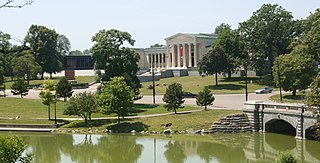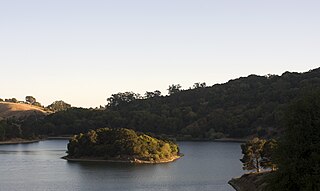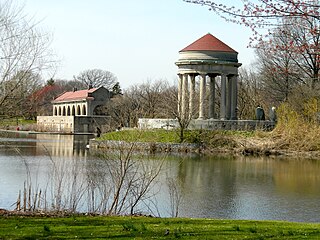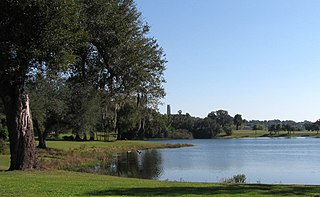
Frederick Law Olmsted was an American landscape architect, journalist, social critic, and public administrator. He is considered to be the father of landscape architecture in the United States. Olmsted was famous for co-designing many well-known urban parks with his partner Calvert Vaux. Olmsted and Vaux's first project was Central Park in New York City, which led to many other urban park designs. These included Prospect Park in Brooklyn; Cadwalader Park in Trenton, New Jersey; and Forest Park in Portland, Oregon. In 1883, Olmsted established the preeminent landscape architecture and planning consultancy of the late 19th-century United States, which was carried on and expanded by his sons, Frederick Jr. and John C., under the name Olmsted Brothers.

Riverside is a suburban village in Cook County, Illinois, United States. The population of the village was 9,298 at the 2020 census. It is a suburb of Chicago, located roughly 9 miles (14 km) west of downtown Chicago and 2 miles (3 km) outside city limits. A significant portion of the village is in the Riverside Landscape Architecture District, designated a National Historic Landmark in 1970.

Riverside Park is a scenic public park on the waterfront of the Upper West Side, Morningside Heights, and Hamilton Heights neighborhoods of the borough of Manhattan in New York City. The park measures 4 miles (6.4 km) long and 100 to 500 feet wide, running between the Hudson River and Henry Hudson Parkway to the west and the serpentine Riverside Drive to the east.

Big Bear Lake is a reservoir in the western United States, located in the San Bernardino Mountains in San Bernardino County, California. It is a snow and rain-fed lake, having no other means of tributaries or mechanical replenishment.

Volunteer Park is a 48.3-acre (19.5 ha) park in the Capitol Hill neighborhood of Seattle, Washington, United States.

Parks in Chicago include open spaces and facilities, developed and managed by the Chicago Park District. The City of Chicago devotes 8.5% of its total land acreage to parkland, which ranked it 13th among high-density population cities in the United States in 2012. Since the 1830s, the official motto of Chicago has been Urbs in horto, Latin for "City in a garden" for its commitment to parkland. In addition to serving residents, a number of these parks also double as tourist destinations, most notably Lincoln Park, Chicago's largest park, visited by over 20 million people each year, is one of the most visited parks in the United States. Notable architects, artists and landscape architects have contributed to the 570 parks, including Daniel Burnham, Frederick Law Olmsted, Jens Jensen, Dwight Perkins, Frank Gehry, and Lorado Taft.

Hyde Park is the southernmost neighborhood of Boston, Massachusetts, United States. Situated 7.9 miles south of downtown Boston, it is home to a diverse range of people, housing types and social groups. It is an urban location with suburban characteristics.

Stewart Park is a municipal park operated by the City of Ithaca, New York on the southern end of Cayuga Lake, the largest of New York's Finger Lakes.

Jefferson Park is a 52.4 acres (0.212 km2) public park and golf course on top of Beacon Hill in Seattle, Washington, bounded on the east by 24th Avenue S. and 24th Place S., on the west by 15th Avenue S., on the north by S. Spokane Street, and on the south by Cheasty Boulevard S.

John Charles Olmsted was an American landscape architect. The nephew and adopted son of Frederick Law Olmsted, he worked with his father and his younger brother, Frederick Law Olmsted Jr., in their father's firm. After their father retired, the brothers took over leadership and founded Olmsted Brothers as a landscape design firm. The firm became well known for designing many urban parks, college campuses, and other public places. John Olmsted's body of work from over 40 years as a landscape architect has left its mark on the American urban landscape.

Delaware Park–Front Park System is a historic park system and national historic district in the northern and western sections of Buffalo in Erie County, New York. The park system was designed by Frederick Law Olmsted and Calvert Vaux and developed between 1868 and 1876.

Mission Bay is an artificial, saltwater bay located south of the Pacific Beach community of San Diego, California, created from approximately 2,000 acres (810 ha) of historical wetland, marsh, and saltwater bay habitat. The bay is part of the recreational Mission Bay Park, the largest man-made aquatic park in the United States, consisting of 4,235 acres (17.14 km2), approximately 46% land and 54% water. The combined area makes Mission Bay Park the ninth largest municipally-owned park in the United States.

Many of the public parks and parkways system of Buffalo, New York, were originally designed by Frederick Law Olmsted and Calvert Vaux between 1868 and 1896. They were inspired in large part by the parkland, boulevards, and squares of Paris, France. They include the parks, parkways and circles within the Cazenovia Park–South Park System and Delaware Park–Front Park System, both listed on the National Register of Historic Places and maintained by the Buffalo Olmsted Parks Conservancy.

Lake Chabot is a man-made lake covering 317 acres (1.3 km2) in Alameda County, California, United States. Part of the lake lies within Oakland city limits, but most of it lies in unincorporated Castro Valley, just east of San Leandro. It was formed by the damming of San Leandro Creek. The lake was completed in 1875 to serve as a primary source of water for the East Bay.

Franklin Delano Roosevelt (FDR) Park is a park located along the Delaware River in the southernmost point of South Philadelphia, Pennsylvania, comprising some 348 acres (1.41 km2), about 125 acres (0.51 km2) of buildings, roadways, pathways for walking, landscaped architecture, and a variety of picnic and recreation areas placed within about 77 acres (310,000 m2) of natural lands including ponds and lagoons.

Riverside Park is a historic park located in the Riverside neighborhood in Buffalo, New York. Located in northwest Buffalo, it is an individual park designed by the Olmsted Architectural Firm in 1898 after Frederick Law Olmsted's retirement. It is on a 22-acre (8.9 ha) site on a bluff overlooking the Niagara River. Riverside Park was designed for active recreation and periodic alterations have occurred as the community's recreation needs have changed. Despite the changes, the park retains numerous original design elements and remains as the final element completed as a part of the Olmsted plan for Buffalo's park system.

Mountain Lake is a private community and U.S. historic district north of the City of Lake Wales, Florida, United States, off the FL 17 Scenic Highway.

Svend Nielsen (1919–2013) was a Danish born architect and architectural engineer. Nielsen with his partner, Carl Johnson, founded the firm Johnson and Nielsen. Nielsen was influential in the construction of many important structures in Southern California, including the Discovery Cube in Orange County, the Coussoulis Arena in San Bernardino and, most famously, the Forum in Inglewood, CA, which was the first structure of its kind to be built without support pillars. The engineering of the Forum was quite a feat as the structural design allowed no obstructed seats in the entire arena.
Bruce R. Kelly was a landscape architect based in New York City, an advocate for the preservation and restoration of landscapes designed by Frederick Law Olmsted. He is also remembered for his own designs in New York's parks, which include Strawberry Fields, the memorial to John Lennon in New York's Central Park.

Riverside Regional Park is an urban park located on the near northwest side of Indianapolis, Indiana, United States. The park is bounded by 38th Street to the north, 18th Street to the south, Riverside Drive to the east, and Cold Spring Road to the west.

























